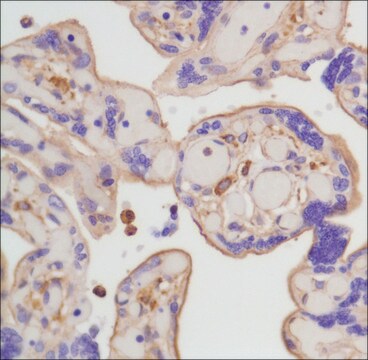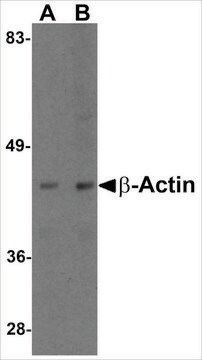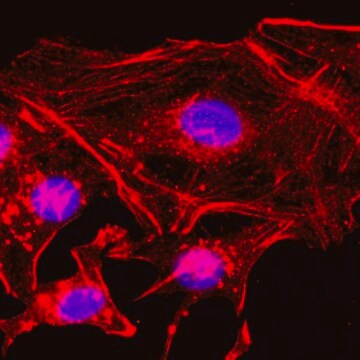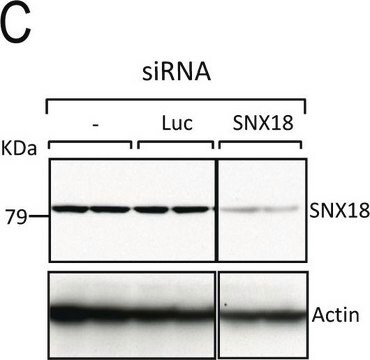ABT264
Anti-beta Actin Antibody, arginylated (N-terminal)
from rabbit, purified by affinity chromatography
Sinonimo/i:
Actin, cytoplasmic 1, arginylated, beta Actin, arginylated
About This Item
Prodotti consigliati
Origine biologica
rabbit
Livello qualitativo
Forma dell’anticorpo
affinity isolated antibody
Tipo di anticorpo
primary antibodies
Clone
polyclonal
Purificato mediante
affinity chromatography
Reattività contro le specie
mouse, rat, human
Reattività contro le specie (prevista in base all’omologia)
orangutan (based on 100% sequence homology), canine (based on 100% sequence homology), rabbit (based on 100% sequence homology), hamster (based on 100% sequence homology)
tecniche
dot blot: suitable
immunocytochemistry: suitable
western blot: suitable
N° accesso NCBI
N° accesso UniProt
Condizioni di spedizione
wet ice
modifica post-traduzionali bersaglio
unmodified
Informazioni sul gene
human ... ACTB(60)
Descrizione generale
Specificità
Immunogeno
Applicazioni
Western Blotting Analysis: 2.0 µg/mL from a representative lot detected N-terminally arginylated beta actin in human (HeLa, HEK293, HepG2, HUVEC, Jurkat, PC3), rat (PC-12 pheochromocytoma), and murine (C2C12 myoblast, NIH/3T3, and Raw 264.7) cell lysates, as well as in human placenta and mouse brain tissue homogenates.
Dot Blot Analysis: 0.2 µg/mL from a representative lot detected immunogen peptide, but not the corresponding peptide without the N-terminus arginine (Courtesy of Dr. Anna Kashina, University of Pennsylvania, Philadelphia, PA).
Western Blotting Analysis: 0.2 µg/mL from a representative lot detected greatly reduced beta actin N-terminal arginylation modification in Arg-transfer RNA (Arg-tRNA) protein transferase (Ate1) knockout mouse embryonic fibroblasts (Courtesy of Dr. Anna Kashina, University of Pennsylvania, Philadelphia, PA).
Note: Goat serum is found to interfere with the staining by this polyclonal antibody, BSA is recommended for sample blocking when using this product.
Cell Structure
Cytoskeleton
Qualità
Western Blotting Analysis: 2.0 µg/mL of this antibody detected N-terminally arginylated beta actin in human A431 cell lysate.
Descrizione del bersaglio
Stato fisico
Stoccaggio e stabilità
Altre note
Esclusione di responsabilità
Non trovi il prodotto giusto?
Prova il nostro Motore di ricerca dei prodotti.
Raccomandato
Codice della classe di stoccaggio
12 - Non Combustible Liquids
Classe di pericolosità dell'acqua (WGK)
WGK 1
Punto d’infiammabilità (°F)
Not applicable
Punto d’infiammabilità (°C)
Not applicable
Certificati d'analisi (COA)
Cerca il Certificati d'analisi (COA) digitando il numero di lotto/batch corrispondente. I numeri di lotto o di batch sono stampati sull'etichetta dei prodotti dopo la parola ‘Lotto’ o ‘Batch’.
Possiedi già questo prodotto?
I documenti relativi ai prodotti acquistati recentemente sono disponibili nell’Archivio dei documenti.
I clienti hanno visto anche
Il team dei nostri ricercatori vanta grande esperienza in tutte le aree della ricerca quali Life Science, scienza dei materiali, sintesi chimica, cromatografia, discipline analitiche, ecc..
Contatta l'Assistenza Tecnica.









